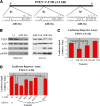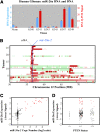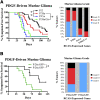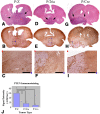The PTEN-regulating microRNA miR-26a is amplified in high-grade glioma and facilitates gliomagenesis in vivo
- PMID: 19487573
- PMCID: PMC2701585
- DOI: 10.1101/gad.1777409
The PTEN-regulating microRNA miR-26a is amplified in high-grade glioma and facilitates gliomagenesis in vivo
Abstract
Activated oncogenic signaling is central to the development of nearly all forms of cancer, including the most common class of primary brain tumor, glioma. Research over the last two decades has revealed the particular importance of the Akt pathway, and its molecular antagonist PTEN (phosphatase and tensin homolog), in the process of gliomagenesis. Recent studies have also demonstrated that microRNAs (miRNAs) may be responsible for the modulation of cancer-implicated genes in tumors. Here we report the identification miR-26a as a direct regulator of PTEN expression. We also show that miR-26a is frequently amplified at the DNA level in human glioma, most often in association with monoallelic PTEN loss. Finally, we demonstrate that miR-26a-mediated PTEN repression in a murine glioma model both enhances de novo tumor formation and precludes loss of heterozygosity and the PTEN locus. Our results document a new epigenetic mechanism for PTEN regulation in glioma and further highlight dysregulation of Akt signaling as crucial to the development of these tumors.
Figures






Similar articles
-
Glioma stem cells-derived exosomal miR-26a promotes angiogenesis of microvessel endothelial cells in glioma.J Exp Clin Cancer Res. 2019 May 17;38(1):201. doi: 10.1186/s13046-019-1181-4. J Exp Clin Cancer Res. 2019. PMID: 31101062 Free PMC article.
-
Long non-coding RNA TUG1 acts as a miR-26a sponge in human glioma cells.Biochem Biophys Res Commun. 2016 Sep 2;477(4):743-748. doi: 10.1016/j.bbrc.2016.06.129. Epub 2016 Jun 27. Biochem Biophys Res Commun. 2016. PMID: 27363339
-
MiR-26a enhances metastasis potential of lung cancer cells via AKT pathway by targeting PTEN.Biochim Biophys Acta. 2012 Nov;1822(11):1692-704. doi: 10.1016/j.bbadis.2012.07.019. Epub 2012 Aug 4. Biochim Biophys Acta. 2012. PMID: 22885155
-
Interactions between PTEN and receptor tyrosine kinase pathways and their implications for glioma therapy.Expert Rev Anticancer Ther. 2009 Feb;9(2):235-45. doi: 10.1586/14737140.9.2.235. Expert Rev Anticancer Ther. 2009. PMID: 19192961 Free PMC article. Review.
-
Non-genomic loss of PTEN function in cancer: not in my genes.Trends Pharmacol Sci. 2011 Mar;32(3):131-40. doi: 10.1016/j.tips.2010.12.005. Epub 2011 Jan 13. Trends Pharmacol Sci. 2011. PMID: 21236500 Review.
Cited by
-
The role of miR-26 in tumors and normal tissues (Review).Oncol Lett. 2011 Nov;2(6):1019-1023. doi: 10.3892/ol.2011.413. Epub 2011 Sep 5. Oncol Lett. 2011. PMID: 22848262 Free PMC article.
-
Aberrant promoter hypermethylation of PBRM1, BAP1, SETD2, KDM6A and other chromatin-modifying genes is absent or rare in clear cell RCC.Epigenetics. 2013 May;8(5):486-93. doi: 10.4161/epi.24552. Epub 2013 May 1. Epigenetics. 2013. PMID: 23644518 Free PMC article.
-
Role of MicroRNAs in Malignant Glioma.Chin Med J (Engl). 2015 May 5;128(9):1238-44. doi: 10.4103/0366-6999.156141. Chin Med J (Engl). 2015. PMID: 25947409 Free PMC article. Review.
-
cAMP response element-binding protein promotes gliomagenesis by modulating the expression of oncogenic microRNA-23a.Proc Natl Acad Sci U S A. 2012 Sep 25;109(39):15805-10. doi: 10.1073/pnas.1207787109. Epub 2012 Sep 10. Proc Natl Acad Sci U S A. 2012. PMID: 23019365 Free PMC article. Clinical Trial.
-
miRNAs and related genetic biomarkers according to the WHO glioma classification: From diagnosis to future therapeutic targets.Noncoding RNA Res. 2023 Oct 7;9(1):141-152. doi: 10.1016/j.ncrna.2023.10.003. eCollection 2024 Mar. Noncoding RNA Res. 2023. PMID: 38035044 Free PMC article. Review.
References
-
- Baehring JM. An update on oligodendroglial neoplasms. Curr Opin Neurol. 2005;18:639–644. - PubMed
-
- Baeza N, Weller M, Yonekawa Y, Kleihues P, Ohgaki H. PTEN methylation and expression in glioblastomas. Acta Neuropathol. 2003;106:479–485. - PubMed
-
- Becher OJ, Hambardzumyan D, Fomchenko EI, Momota H, Mainwaring L, Bleau AM, Katz AM, Edgar M, Kenney AM, Cordon-Cardo C, et al. Gli activity correlates with tumor grade in platelet-derived growth factor-induced gliomas. Cancer Res. 2008;68:2241–2249. - PubMed
Publication types
MeSH terms
Substances
LinkOut - more resources
Full Text Sources
Other Literature Sources
Molecular Biology Databases
Research Materials
